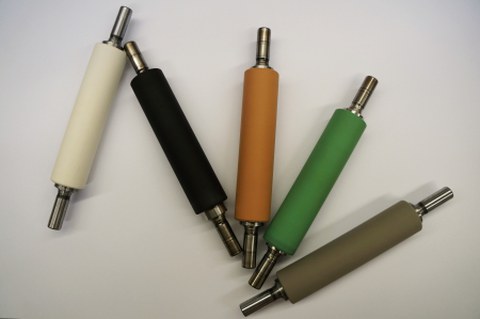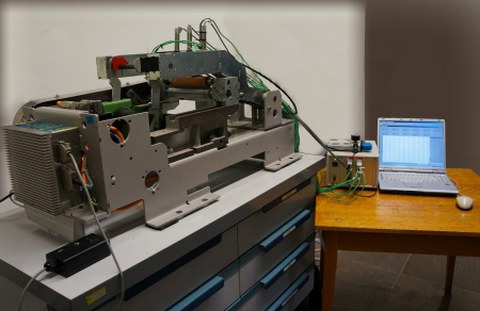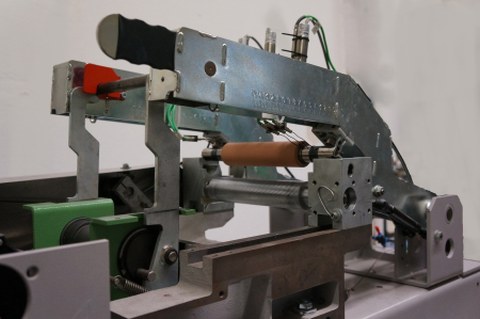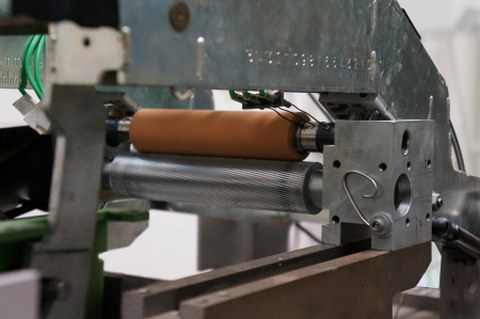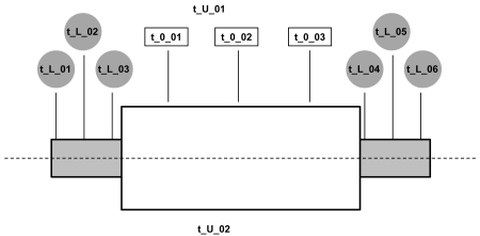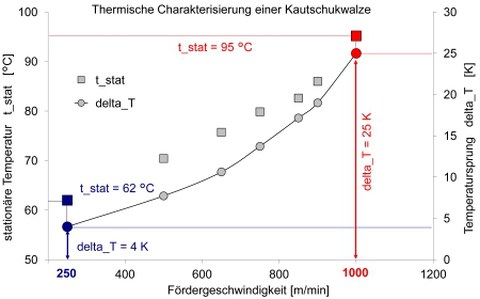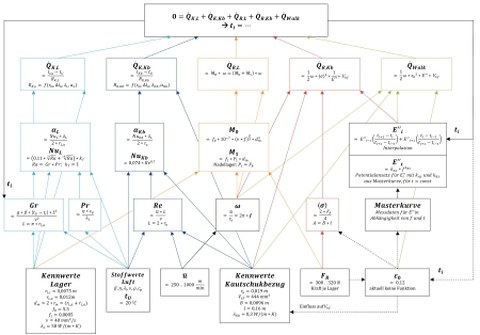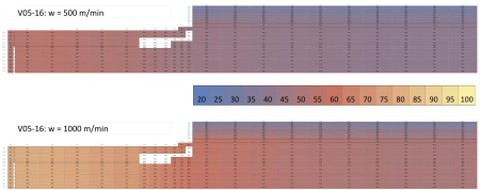Active cooling of fast rotating rubber rollers
Project name: Design and model-based balancing of concepts for active cooling of fast rotating rubber rollers
Brief description: thermodynamic design and optimisation - targeted development of an active cooling system for dynamically loaded rubber rollers, modelling and metrological testing under practical conditions
Funding: BMWi ZIM Cooperation Project, FKZ KF2006417WZ3, Project Management Agency: AiF Projekt GmbH
Project start, duration: June 2013, two years
Project partners
- TU Dresden, Institute for Energy Technology, Chair for Building Energy Technology and Heat Supply
- TU Dresden, Institute of Process Engineering and Environmental Technology, Chair of Thermal Process Engineering and Environmental Technology
- Hans Stark e. K., Sontheim: Stark produces ready-to-install rubber rollers, plastic rollers and roller cores for various applications according to customer specifications. The material and design of the rollers and roller coverings are precisely matched to the respective requirements and ensure efficient production processes. Stark also manufactures rubber mouldings and rubber-metal compounds.
- Christian Maier GmbH & Co. KG, Heidenheim: Maier is the technology leader for rotary joints and offers its customers worldwide the highest quality and highest benefit in rotary joints and service. Maier achieves this through intensive development, flanked by targeted testing in our own laboratory and in practice. Maier rotary joints are fittings for the connection of pipelines to rotating rollers and units for the passage of media under pressure and temperature.
Project description
Problem: Elastomer components (rubber) heat up under dynamic load, which leads to high operating temperatures. This leads to machine downtimes and a reduced service life of the components. Up to now, these problems can only be avoided by reducing process speed, which considerably limits machine efficiency and thus productivity.
Thermodynamic approach for the targeted reduction of the temperature of rubber rollers: The project objective is the product development of an actively cooled rubber roller for use in textile machines.
Solution: All influencing factors that contribute to heat generation are recorded and taken into account in the balance model. On this basis, cooling concepts are adapted and matured for the production of prototypes. The prototypes are metrologically validated in laboratory scale at the TU Dresden. The final practical testing of the modified rubber rollers takes place on the real machine under production conditions.
Thermal characterisation of dynamically loaded rubber rollers
Two thermal problems arise during the operation of dynamically loaded rubber rollers:
- High stationary surface temperature and
- Temperature jump on roller surface when the machine is stopped.
For the thermodynamic evaluation of rubber rollers we have developed a method for thermal characterisation. For this purpose, the rollers are examined metrologically with regard to their heating behaviour. With our new characterisation method, various measures for improving the thermal management of the rollers can now be compared transparently.
Test setup
At the TU Dresden, we can measure the operation of the rollers in a balance-sheet closing, reproducible and with high accuracy. For our investigations on a laboratory scale, we have equipped a test facility with temperature sensors in accordance with the high-performance line of the company Rieter. The roller to be tested is clamped in the test set-up and pressed onto the drive roller. The conveying speed (up to 1000 m/min) and the contact pressure (between 100 and 380 N) can be varied as adjustable boundary conditions.
Concept for thermal characterisation
For the different conveying speeds, the roller is driven until the stationary thermodynamic state is reached and then the rotation is suddenly stopped. From the recorded temperature curves the stationary temperature t_stat and the temperature jump delta_T are determined. It can be seen that with increasing speed the stationary temperature and the temperature jump increase.
Balance sheet model
The balance model is a tool for the energy balance of dynamically loaded rubber rollers. In the model, roller shaft, rubber cover and the bearings are considered. Based on the test set-up, the influencing factors for the modelling are determined: Conveying speed, contact pressure, ambient temperature, thermal conductivity and complex elasticity module of the rubber. The heat source flows are the frictional power at the bearing and at the rubber, the flexing power in the rubber and the convection at the bearing and at the rubber surface.
In order to be able to represent the temperature distribution in the roller depending on various parameters, the model calculates cell by cell. With the boundary conditions, the energy balance is solved iteratively for each cell and the temperature is calculated. Thus the temperature distribution in the rubber, in the shaft core and in the bearings is obtained with the balance model.
Publications and lectures
- Thermische Charakterisierung dynamisch belasteter Kautschukwalzen - Validierung des Messkonzepts, melliand Textilberichte - European Textile Journal, 94 (2013) No. 1, S. 42-43, Kasper, T.; Treppe, K.; Schinke, L.; Hickmann, R.; Cherif, C.
- Thermodynamically Characterisation of Rubber Rollers, 13. AUTEX World Textile Conference 2013, Dresden, 22.-24. Mai, Poster, Schinke, L.; Treppe, K.; Hickmann, R.; Cherif, C.
- Method of experimental Investigation on Flexing Work in dynamic forced Rubber Rollers, 6. Aachen-Dresden International Textile Conference, 29.-30. November 2012, Kurzreferateband, S. 263, Hickmann, R.; Schinke, L.; Treppe, K.; Cherif, C.
- Dynamisch belastete Kautschukwalzen – Messen, Bilanzieren, thermisch Optimieren, 97. Betriebsleiteraussprache, Industrieverband Veredlung - Garne - Gewebe - Technische Textilien e.V. (IVGT), Übach-Palenberg, 17. Oktober 2012, Schinke, L.; Treppe, K.; Hickmann, R.
- Thermische Charakterisierung dynamisch belasteter Kautschukwalzen, melliand Textilberichte - European Textile Journal, 93 (2012) No. 1, S. 48-49, Schinke, L.; Treppe, K.; Hickmann, R.; Cherif, C.
- Reduction of Surface Temperature of Rubber Cylinders, 5. Aachen-Dresden International Textile Conference, 24.-25. November 2011 Kurzreferateband, S. 144, Hickmann, R.; Schinke, L.; Treppe, K.; Diestel, O.; Cherif, C.
Documentary and diploma theses
- Dynamisch belastete Kautschukwalzen - Bilanzmodell, Tobias Kasper, Großer Beleg, Mai 2013
- Dynamisch belastete Kautschukwalzen - Stand der Technik Kühlverfahren, Sophie Fischer, Großer Beleg, Oktober 2012
- Thermische Charakterisierung dynamisch belasteter Kautschukwalzen, Tobias Kasper, Kleiner Beleg, September 2012
- Frühe Abschätzung von Effizienz- und Wirtschaftlichkeitsvorteilen der neuen und schnell rotierenden Kautschukwalze an einem Fallbeispiel aus der Textilindustrie, Robert Kamischke, Bachelorarbeit, August 2010


